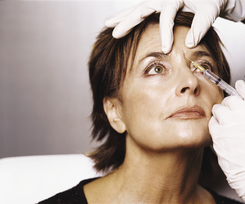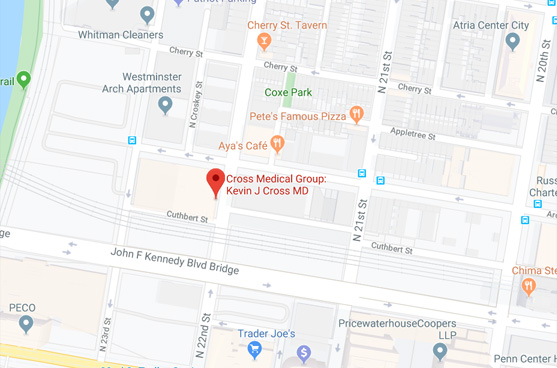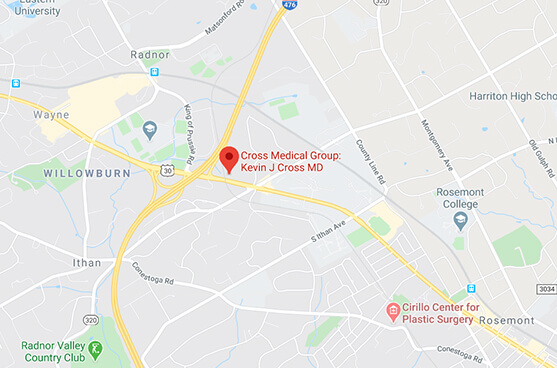Working Out New Wrinkles
Working Out New Wrinkles
November 18, 2014 By:
Carol Saline, Inside Magazine feature
 I haven’t been to one birthday party recently for someone over 60 where most of the women in the room don’t look five to 10 years younger than the age on their driver’s license. The reason that 70 is the new 60 and 50 is the new 40 isn’t the discovery of the Fountain of Youth by some intrepid explorer. The magician is either a dermatologist or a cosmetic surgeon armed with a vast array of peels, lasers, surgical nips and tucks, and fancy heat and light therapies that can miraculously turn back the clock — at least temporarily.
I haven’t been to one birthday party recently for someone over 60 where most of the women in the room don’t look five to 10 years younger than the age on their driver’s license. The reason that 70 is the new 60 and 50 is the new 40 isn’t the discovery of the Fountain of Youth by some intrepid explorer. The magician is either a dermatologist or a cosmetic surgeon armed with a vast array of peels, lasers, surgical nips and tucks, and fancy heat and light therapies that can miraculously turn back the clock — at least temporarily.
Just a few decades ago, a woman who wanted to look younger (men didn’t hop on the bandwagon until more recently) had two choices: a face-lift or a chemical peel, both of which required deep pockets and the willingness to hide in your house for a month. Back then, the prevailing technique for face-lifts pulled the skin so tightly that it stretched over the face like a snug stocking. And the chemical peels often left patients scarred or white as ghosts. Aging society dames smiling from the social pages either looked old and wrinkly like their money or as if they were wearing masks. If you’d had “work done” — the euphemism for cosmetic surgery — it was fairly obvious.
Not so today. The current approach to ageless beauty is to start young, do less and gradually build up to more. In South America, women typically begin some kind of skin resurfacing in their 20s. In the United States, 40 is a more common age to take the plunge — that’s when the mirror starts to reflect the early signs of aging in your skin texture and elasticity. Most likely, the gateway procedure will be Botox, a wrinkle-relaxing injection classified as a neuro-modulator. Six million Botox injections were performed in 2013 to treat wrinkles, crow’s feet and frown lines. It’s been around long enough that its safety and efficacy are well proven. Center City dermatologist Dr. Jason Neustadter believes that if you took two 35-year-olds and began using Botox on one and not the other, all things being equal, the woman using Botox would have fewer wrinkles 10 years later. “The reason,” he says, “is that Botox would prevent her from creating the wrinkles that come from repeated facial motion.”
Botox is the leading injectable, but by no means the only one. Equally popular are the injections known as fillers, which are used to plump up fine lines and wrinkles or replace lost volume. Barbra Streisand acknowledges using fillers with a why-wouldn’t-I insouciance. New facial fillers are constantly entering the market to replace old staples. Years ago, collagen and silicone injections were all the rage; nobody uses them today. The current front-runners are from the family of hyaluronic acids, which come from a carbohydrate occurring naturally in the body that holds water and keeps skin radiant and hydrated. Juvederm, Restylane and Perlane are hyaluronic acids of varying viscosity used to soften worry lines. Belletario, introduced in 2012, is the thinnest of the hyaluronic acids and favored by Dr. Neustadter for filling those vertical lines over the upper lip that my aging mother’s lipstick used to bleed into like so much spilled beet juice. The latest rage is a hyaluronic acid called Voluma. As its name suggests, it’s aimed at restoring volume. For some maddening reason, as we age our stomachs get fuller and our cheeks get flatter, our jawlines droop and our chins get flabby. Voluma is placed under the muscle and deeper into the skin than other fillers so that it both lifts and fills. Welcome back, cheekbones! The results are immediate and last up to two years.
Sculptra is another type of injectable that was initially used to improve the sunken visages of AIDS patients. Unlike other fillers, it creates volume by stimulating collagen, the structural protein that supports the skin. (Collagen is the target for just about every youth-restoring procedure because it’s the linchpin in the scaffolding that holds up the skin. Collagen production gradually diminishes with aging, causing faces to sag.) Another option is Radiesse, a putty-like substance made from calcium-based microspheres that acts as a collagen stimulator and a volumizer. A significant advantage to injectables is that you are in and out of the doctor’s office in no time, with virtually no recovery except for a possible bruise mark or redness at the site. Fillers can cost from $500 to $1,000 per vial and last one to two years. The choice of which filler is best for you should be left to your doctor. They all seem to have their preferences and can guide you on what suits your needs. Be advised that the doctor’s skill and training in injectables is a critical factor — so don’t go bargain shopping!
Unfortunately, as time marches on, fillers may not be enough of a defense against aging’s onslaught. You might have to move to the next step: skin resurfacing and tightening. Here is where the wicket gets sticky. New products and techniques are constantly emerging to rave reviews, but the research to support them tends to be less scientific and more anecdotal. Once again, it’s best to rely on a doctor you trust to steer you in the right direction depending on factors like your age, your weight, your skin quality, elasticity, etc.
If you were to visit Dr. Kathy Rumor, a former aerospace engineer who became a plastic and reconstructive surgeon nine years ago, she might recommend PRP (platelet-rich plasma) microinjections. PRP has been successfully used for more than a decade in orthopedics and wound care to promote healing. Because plasma is thought to be rich in growth factors, it’s migrated to skin care, where it’s purported to stimulate collagen formation. A small amount of the patient’s own blood gets spun in a centrifuge to separate out the platelet-rich plasma which is then spread over a numbed face. Dozens of micro-needles puncture the skin so the plasma enters deep into the underlayers. “It gets incorporated in the collagen,” explains Rumor, “where it revives tissue, increases volume, improves blood supply and gives the patient a natural radiance and glow.” She also uses PRP in hair restoration to revitalize follicles. Because PRP is blood-based, it’s been nicknamed “The Vampire.”
Rumor is also very high on Thermi RF, a minimally invasive neck-lift done in the office, which revs up collagen by sending radio-frequency heat waves under the skin through a cannula the size of a coffee stirrer. The heat gets rid of excess fat and contracts loose skin. She likes to couple it with a laser treatment called ClearLift for tightening crepe-y skin around the jaw and neck.
Skin rejuvenation has been revolutionized by the development of all kinds of lasers designed to restore the bloom of youth. The key words in laser resurfacing are “ablative” and “nonablative.”
Ablative (or invasive) lasers are the most aggressive. They remove the top layer of skin by essentially creating a burn-type wound that stimulates the growth of new skin. Ablative lasers are good for deeper wrinkles, older skin, sun damage and deep acne scars. Recovery from the redness, which looks like a really bad sunburn, can take two to four weeks. Nonablative (or noninvasive) lasers bypass the top layer of skin and work by delivering heat to the tissue beneath to instigate collagen growth. These lasers work best on fine lines, mild wrinkles and some age spots. Recovery is usually overnight; expect some mild redness. There is a downside to the no-downtime bonus of nonablative lasers: You will probably require several treatments to see significant results.
There’s an intermediate option called Fraxel. This laser targets both the top and mid-layer of the skin by delivering thousands of tiny columns of deep heat over the surface and into the skin. There are different levels of Fraxel treatment with varying recovery times. Expect improvements — but nothing terribly dramatic — and plan on more than one treatment to produce significant change. That’s where the dollars add up.
Laser treatments are usually done by a dermatologist or a cosmetic surgeon. Dr. Franziska Ringpfiel, a Haverford dermatologist who specializes in noninvasive skin resurfacing, raves about Picosure, a pressure wave that sends short bursts of energy straight into the dermis (the second layer of skin). “No downtime, no pain,” she says, “and amazing results.” Plan on several treatments spaced three to four months apart at $500 a pop. She is also high on photo-dynamic therapy for tightening and toning by means of a visible light beam on skin that’s been painted with a photosensitizer.
Clinical aestheticians will frequently offer gentle laser treatments as part of their services — kind of a lunchtime brightener. Ellen Ehrlich of Main Line Center for Laser Surgery likes Clear and Brilliant for improving skin tone and the E Matrix radio-frequency laser for simulating collagen and softening lip lines. Jane Marie Amato uses IPL (intense pulse light) for treating rosacea, getting rid of red spots due to broken capillaries and brown spots from sun damage. She endorses ClearLift Laser for fine lines and Rejuvapen for collagen stimulating. “All the lasers that we aestheticians use,” she says, “can’t make a 50-year-old look 30, but she will look rested and refreshed.”
Dr. Kevin Cross is the go-to plastic surgeon for the cognoscenti in Philadelphia. In his opinion, “There are a million things out there that claim to tighten skin and most of them don’t, except for Ultherapy. It has been studied and proven, and nobody else has their science.” Ultherapy employs ultrasound waves to penetrate the skin and create heat that tightens collagen at a deep dermal layer. Cross says that 80 percent of his patients get a four- to five-star result for two to three years, but it’s not for everybody. “You’re likely to be happier with the outcome at 50 than at 70,” he says. The procedure takes about an hour with what most people report as tolerable discomfort.
Despite the restorative wonder of lasers and peels, the proven path back to lost youth leads to the operating room. The approach today has shifted from full-blown face-lifts toward working on targeted areas. “Most of my patients can point a finger to the part that bothers them,” says Cross. “There’s been a shift from asking the doctor, ‘What can you do to make me look better?’ to saying ‘I’d like to improve this or that. How can you do it?’ ” Hint: When you look in the mirror and use your fingers to pull the skin of your neck and jowls, you need a neck-lift.
Today, that’s a relatively simple procedure with about a week of recovery, mostly due to swelling and bruising. When you adjust your mirror image by pulling your hair back to get rid of crow’s feet and saggy eyelids, you need a modified brow lift. Popularly called the “Ponytail Lift,” this is a minimally invasive surgery that makes tiny incisions at the edge of the brow line to tighten the muscles that hold up the forehead and upper eye. It can be done in the office, with a week or so for recovery.
If you can’t pinpoint a target, you’re probably a candidate for a full face-lift. Surgeons used to try to reverse aging mainly by tightening and pulling skin. Now it’s understood that aging is not only a problem of loose skin but also just as much one of lost volume. “Almost every face-lift I do now involves injecting some of the patient’s own fat to replace volume,” Cross says. “We are at the point where that’s now state of the art.”
Facial aging is not rocket science. As we pile on years, the support structures of our once-youthful visage get stretched and tired, leading to loose, sagging skin, a decrease in volume and changes to the skin surface that cause wrinkles, age spots and enlarged pores. To a great extent, all of these can be improved with the magic hands of a good doctor. Maybe it’s ultimately true that you can’t fool Mother Nature, but you can send her packing for a while and fool just about everyone else.
Carol Saline is the chief medical affairs correspondent for Inside. This article originally appeared in Inside Magazine, a Jewish Exponent publication.




